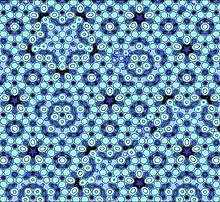
A quasiperiodic crystal, or quasicrystal, is a structure that is ordered but not periodic. A quasicrystalline pattern can continuously fill all available space, but it lacks translational symmetry.[2] While crystals, according to the classical crystallographic restriction theorem, can possess only two-, three-, four-, and six-fold rotational symmetries, the Bragg diffraction pattern of quasicrystals shows sharp peaks with other symmetry orders—for instance, five-fold.[3]
Aperiodic tilings were discovered by mathematicians in the early 1960s, and, some twenty years later, they were found to apply to the study of natural quasicrystals. The discovery of these aperiodic forms in nature has produced a paradigm shift in the field of crystallography. In crystallography the quasicrystals were predicted in 1981 by a five-fold symmetry study of Alan Lindsay Mackay,[4]—that also brought in 1982, with the crystallographic Fourier transform of a Penrose tiling,[5] the possibility of identifying quasiperiodic order in a material through diffraction.
Quasicrystals had been investigated and observed earlier,[6] but, until the 1980s, they were disregarded in favor of the prevailing views about the atomic structure of matter. In 2009, after a dedicated search, a mineralogical finding, icosahedrite, offered evidence for the existence of natural quasicrystals.[7]
Roughly, an ordering is non-periodic if it lacks translational symmetry, which means that a shifted copy will never match exactly with its original. The more precise mathematical definition is that there is never translational symmetry in more than n – 1 linearly independent directions, where n is the dimension of the space filled, e.g., the three-dimensional tiling displayed in a quasicrystal may have translational symmetry in two directions. Symmetrical diffraction patterns result from the existence of an indefinitely large number of elements with a regular spacing, a property loosely described as long-range order. Experimentally, the aperiodicity is revealed in the unusual symmetry of the diffraction pattern, that is, symmetry of orders other than two, three, four, or six. In 1982, materials scientist Dan Shechtman observed that certain aluminium–manganese alloys produced the unusual diffractograms which today are seen as revelatory of quasicrystal structures. Due to fear of the scientific community's reaction, it took him two years to publish the results[8][9] for which he was awarded the Nobel Prize in Chemistry in 2011.[10] On 25 October 2018, Luca Bindi and Paul Steinhardt were awarded the Aspen Institute 2018 Prize for collaboration and scientific research between Italy and the United States, after they discovered icosahedrite, the first quasicrystal known to occur naturally.
- ^ Ünal, B; V. Fournée; K.J. Schnitzenbaumer; C. Ghosh; C.J. Jenks; A.R. Ross; T.A. Lograsso; J.W. Evans; P.A. Thiel (2007). "Nucleation and growth of Ag islands on fivefold Al-Pd-Mn quasicrystal surfaces: Dependence of island density on temperature and flux". Physical Review B. 75 (6): 064205. Bibcode:2007PhRvB..75f4205U. doi:10.1103/PhysRevB.75.064205. S2CID 53382207. Archived from the original on 2020-07-28. Retrieved 2018-12-21.
- ^ Cite error: The named reference
r9was invoked but never defined (see the help page). - ^ Lifshitz, Ron; Schmid, Siegbert; Withers, Ray L. (2013). Aperiodic crystals. Springer. OCLC 847002667. Archived from the original on 2024-09-18. Retrieved 2022-12-13.
- ^ Alan L. Mackay, "De Nive Quinquangula", Krystallografiya, Vol. 26, 910–919 (1981).
- ^ Alan L. Mackay, "Crystallography and the Penrose Pattern", Physica 114 A, 609 (1982).
- ^ Steurer W. (2004). "Twenty years of structure research on quasicrystals. Part I. Pentagonal, octagonal, decagonal and dodecagonal quasicrystals". Z. Kristallogr. 219 (7–2004): 391–446. Bibcode:2004ZK....219..391S. doi:10.1524/zkri.219.7.391.35643.
- ^ Cite error: The named reference
r5was invoked but never defined (see the help page). - ^ Cite error: The named reference
bloombergwas invoked but never defined (see the help page). - ^ Cite error: The named reference
swas invoked but never defined (see the help page). - ^ Cite error: The named reference
nobelwas invoked but never defined (see the help page).